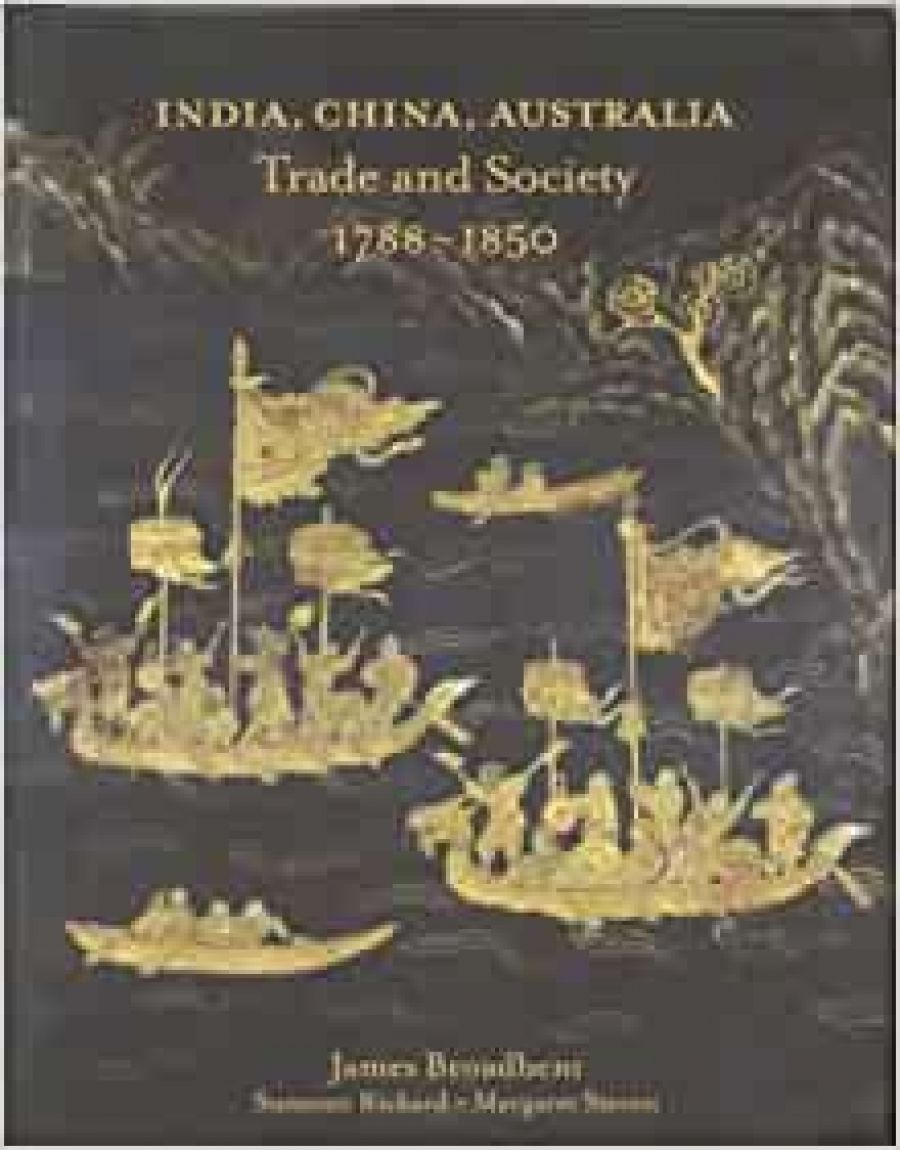
- Free Article: No
- Contents Category: History
- Review Article: Yes
- Article Title: Early Traffic
- Online Only: No
- Custom Highlight Text:
Studies of nineteenth-century decorative arts in Australia have largely focused on objects – furniture, silver, ceramics – produced in Australia for the home market, rather than on a systematic study of imports. The design sources for Australian-made furnishings during the nineteenth century were mostly British; this is also reflected in Britain’s being the principal source of exports to Australia. Given the vast amount of imports from Asia available today – from tableware to mobile telephones, and much of it demonstrating the latest in technology – one could be excused for thinking that our reliance on Asian trade is a twentieth- century phenomenon. Not so. As India, China, Australia: Trade and society 1788–1850 amply demonstrates, our trade with Asia began in the eighteenth century – even ensured the survival of the fledgling port of Sydney – and we have never looked back.
- Book 1 Title: India, China, Austraila
- Book 1 Subtitle: Trade and society 1788 - 1850
- Book 1 Biblio: Historic Houses Trust of New South Wales, $120hb, 207pp
James Broadbent opens with a discussion of Horsely, near Parramatta, an Anglo-Indian bungalow of the 1830s and its Anglo-Indian furnishings, which even ran to a punkah in the dining room. Anglo-Indian immigration to Australia during the early nineteenth century was encouraged by land grants and the climate. For retirees, it was a considerably cheaper alternative than returning to Britain. Naturally, these immigrants brought furnishings with them, including Indian-made furniture in the English style. A more important avenue for the dissemination of goods from India and China in Australia was, of course, trade. As Margaret Steven observes in her chapter ‘Eastern Trade’, Sydney was strategically placed as a trading post for Asian merchants, being a five-week voyage from both India and China. During its first thirty years, the settlement was visited by more than 100 trading vessels from India. And the trade was not all one-way, although an attempt to sell Tasmanian wool in Canton in 1830 was a failure: most ended up as upholstery stuffing, as the Chinese had no idea how to process it. Suzanne Rickard, in ‘Lifelines from Calcutta’, explores the human contact between Sydney and India. These chapters form the basis for the ensuing discussions of surviving material culture, the focus of the book, and its raison d’être.
Since most furniture and silver objects available in Australia during the nineteenth century were either imported from Britain or made locally, those imported from, or made in, India or China have been largely overlooked or regarded as curiosities. Advertisements for Indian and Chinese furniture appeared in the Australian press from the early nineteenth century, indicating a clear identification of its origin for the buyer. At this distance, and with few provenanced examples to assess, the task of determining the origin of such furniture is not an easy one. Indian furniture brought to Australia either by settlers or traders was in general produced for the Anglo market, and thus more or less followed English taste and fashions. It can be difficult to distinguish it from Australian or English furniture. In contrast, Chinese export furniture, often unmistakably Chinese in appearance, found a market in Australia that accepted its exoticism. Timbers can also be a factor in determining the origin, as furniture made from teak is most likely to have been Indian or Chinese. More ambiguous is furniture made from cedar: the same tree also grew in India, and as early as 1795 Australian cedar was also exported to India. Through a stylistic comparison, Broadbent attempts to unravel these complexities of Australian and Anglo-Indian colonial furniture. Similarly, India and China supplied silver objects to Australia, a notable early order being a cutlery service acquired by the Macarthur family from a Canton dealer in 1815.
Fortunately, the recent study of the wrecking of the Sydney Cove in Bass Strait in 1797 has revealed a large cargo of Chinese export ceramics from this earliest period in Sydney’s history. As would be expected, trade in Chinese ceramics to Australia flourished during the nineteenth century. In addition to the few surviving colonial commissions, there are splendid porcelain punchbowls decorated with panoramas of Sydney. Further chapters document and contextualise fancy goods and curiosities, textiles and architecture.
The Historic Houses Trust of New South Wales has produced yet another handsome publication, attractively designed and generously illustrated in colour. Useful and informative appendices show just how important and expansive the trade between Sydney, India and China was. India, China, Australia: Trade and society 1788–1850 was produced to accompany the exhibition of the same name held at the Museum of Sydney in 2003. It forms a substantial addition to the study of Australia’s late eighteenth- and early nineteenth-century material culture. It will be interesting to see who takes up the challenge to study the period after 1850, when the cities of Melbourne, Adelaide, Brisbane and Perth enter the picture, with more surviving objects and greater documentation of this fascinating subject.


Comments powered by CComment